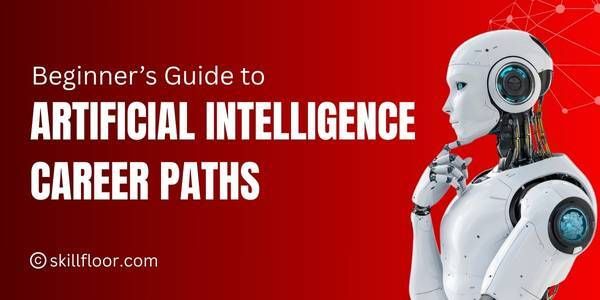Artificial Intelligence Course Syllabus: A Comprehensive Guide
"Discover the future of data science with our comprehensive AI course syllabus. Gain valuable insights into advanced techniques and applications. Enroll now!"

Are you fascinated by the world of Artificial Intelligence (AI)? Do you want to delve into the realm of intelligent machines and explore the endless possibilities they offer? If so, you're in the right place! In this blog, we will take you through an exciting journey as we explore the syllabus of an Artificial Intelligence course. So, fasten your seatbelts and get ready to embark on a thrilling AI adventure!
Introduction to Artificial Intelligence
Welcome to the world of Artificial Intelligence (AI)! In this blog, we will explore the syllabus of an Artificial Intelligence course, covering key topics that will give you a solid foundation in AI. We'll start by delving into the basics of AI, including its definition, historical development, and wide-ranging applications across various industries.As we progress, we will distinguish between Narrow AI, which focuses on specific tasks, and General AI, which aims to replicate human-level intelligence. Understanding these distinctions will provide valuable insights into the capabilities and limitations of AI systems.
Machine Learning Fundamentals
We'll begin by diving into the different types of machine learning, namely supervised, unsupervised, and reinforcement learning. You will understand how these approaches differ in their learning paradigms and the types of problems they can solve. Whether it's predicting future outcomes, finding hidden patterns in data, or teaching an agent to make optimal decisions, machine learning has a solution for every problem.Next, we'll explore some of the popular machine learning algorithms that you will encounter in your course. From linear regression to logistic regression, decision trees to support vector machines, you will gain insights into their underlying principles and learn how to apply them to real-world datasets.
Deep Learning and Neural Networks
Neural networks are inspired by the structure and function of the human brain. We will explore their architecture, including the role of neurons, layers, and activation functions. You will gain a deeper understanding of how neural networks learn from data and make predictions by adjusting their weights and biases.To dive into the practical side of deep learning, we will introduce you to popular deep learning frameworks: TensorFlow and PyTorch.
Natural Language Processing (NLP)
NLP is an area of AI that focuses on understanding and processing human language. It plays a crucial role in many applications, from chatbots and virtual assistants to language translation and sentiment analysis. We will begin by introducing you to the fundamentals of NLP and discussing its significance in today's digital world.
Text preprocessing is a critical step in NLP, as it helps to transform raw text data into a format that can be effectively analyzed by machine learning models. You will learn essential techniques such as tokenization, which involves breaking down text into individual words or tokens, and stemming and lemmatization, which reduce words to their base form.
Computer Vision
Computer vision is a field of AI that focuses on enabling computers to interpret and understand visual information from images or videos. In this section, we will start by covering the fundamentals of computer vision and image processing. You will learn about image representation, color spaces, image filtering, and various techniques for enhancing and manipulating images.One of the most exciting applications of computer vision is image classification, which involves training machines to recognize and categorize objects within images. We will explore convolutional neural networks (CNNs), a powerful deep learning architecture that has revolutionized image classification.
Reinforcement Learning
Reinforcement learning is a subfield of AI that focuses on training agents to make sequential decisions in an environment to maximize cumulative rewards. In this section, we will start by understanding the core concept of reinforcement learning and how it differs from other machine learning approaches. You will learn about the agent-environment interaction, rewards, and the goal of maximizing long-term cumulative rewards.
To model the decision-making process in reinforcement learning, we will explore Markov Decision Processes (MDPs). MDPs provide a mathematical framework for representing sequential decision problems.
AI Ethics and Responsible AI
Transparency in AI is another crucial aspect we will cover. As AI systems become more complex, it is essential to understand how they make decisions. We will discuss methods for interpreting and explaining AI models to provide transparency and build trust.
Responsible AI practices and guidelines will be a central focus in this section. We will explore ethical frameworks and guidelines for developing and deploying AI systems. Understanding the social, legal, and privacy implications of AI is vital to ensure that AI technologies are used in a manner that aligns with societal values.
AI in Practice
To enhance your practical skills, we will provide hands-on projects that allow you to implement AI techniques in practical scenarios. These projects will enable you to apply the knowledge gained throughout the course to real-world problems. You will have the opportunity to work with datasets, develop and train AI models, and evaluate their performance.
Collaborative work and team projects will be an integral part of this section. We believe that simulating real-world AI development through team-based projects fosters a dynamic learning environment. By working collaboratively with your peers, you will gain experience in problem-solving, communication, and project management, which are essential skills in the AI industry.
Advanced Topics in AI
Generative adversarial networks (GANs) have gained significant attention in recent years for their ability to generate realistic and high-quality synthetic data. We will dive into the underlying concepts of GANs and explore their applications in various domains, such as image generation, text synthesis, and even music composition.
Transfer learning is another exciting area of research that focuses on leveraging knowledge learned from one domain to improve performance in another domain. We will study transfer learning techniques and understand how they can be applied to different AI tasks, allowing models to learn faster and perform better.
Summing up, The course will then take you through the key components of AI, starting with machine learning. You will learn about supervised, unsupervised, and reinforcement learning, and gain hands-on experience with popular algorithms and tools. Moving forward, you will delve into neural networks, deep learning frameworks, and specialized techniques such as NLP, computer vision, and reinforcement learning.
Ethical considerations and responsible AI practices will be emphasized throughout the course, ensuring that you understand the importance of fairness, transparency, and bias mitigation in AI applications. Real-world case studies and projects will provide practical insights into implementing AI techniques in various industries, fostering collaboration and teamwork.



























































